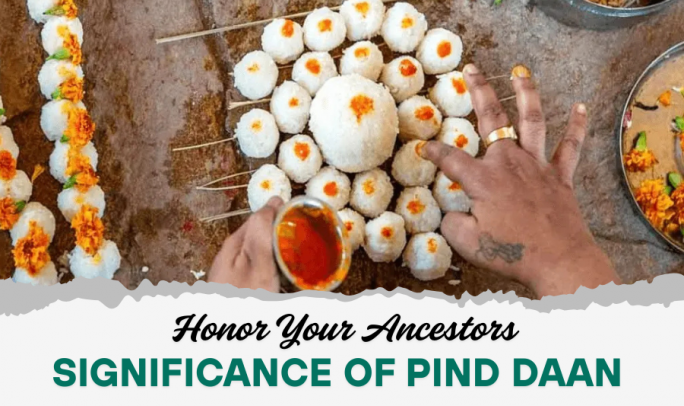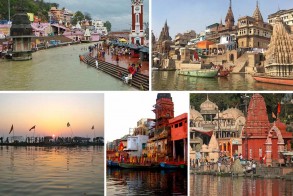Lastjourney Blog
Guide to Pind Daan: Importance , Rituals, and Costs

 Table of Contents
Table of Contents- Key Takeaways
- What is Pind Daan
- Sacred Locations for Pind Daan
- Significance of Performing Pind Daan in Gaya
- Key Rituals and Offerings in Pind Daan
- Cost Involved in Performing Pind Daan
- Estimating Pind Daan Cost
- Charges for Pandit Ji’s Services
- Women's Role in Pind Daan
- Benefits of Pind Daan
- Pind Daan During Special Conditions
- Summary
Pind Daan is a holy Hindu ceremony conducted to please departed ancestors and guide their souls towards peace and liberation. Through particular oblations and prayers termed "pinda", the ceremony forges the spiritual connection between the living and the dead. This text delves into the significance, significance, main ceremonies, and approximate expenditure of Pind Daan—particularly at the holy location of Gaya Ji, while also touching upon an overlooked facet: the advantages of performing Pind Daan.
Key Takeaways
- Pind Daan is a deep Vedic ritual that aims to deliver peace and freedom (moksha) to ancestral spirits.
- Gaya, Bihar, has the most religious importance for Pind Daan, particularly in the Shraadh Paksha.
- Expenses can differ extensively based on transportation, accommodation, and the extent of rituals—pre-planning is important.
What is Pind Daan
Pind Daan is a traditional sacred Hindu rite to offer peace upon the souls of departed ancestors. The word 'pinda' means rice or barley flour balls, representing the physical body of the deceased. During the ceremony, these offerings are placed in memory of the soul, with prayers offered that its soul may attain moksha, or liberation from the cycle of birth.
The concept of Pind Daan is far more than just traditional; it is a spiritual obligation that dignifies the equilibrium between the living and the departed. It is widely believed that a Gayaji Pind Daan or at the sites of Brahma Kapal is most beneficial in directing the ancestral souls toward salvation and eternal tranquillity.
Also Read, Exploring Cremation Services in Different Religions
Sacred Locations for Pind Daan
The most sacred sites in India for performing Pind Daan are Gaya Ji, located in Bihar. Gaya is one of the sacred places in Indian mythology;say it is the place where Lord Ram performed the Pind Daan for his father, King Dasharatha.
The Vishnu Pad Temple, which enshrines the holy footprint of Lord Vishnu, and the Falgu River, known for its purifying powers, enhance the potency of the sacred rites performed there. Pilgrims also visit other important locations, like Brahma Kapal, where it is said the Pind Daan was first initiated by Lord Brahma.
Out of Gaya, some other important sites are Varanasi, Haridwar, Prayagraj, and Badrinath, which is yet another site of Brahma Kapal. Gaya has no parallels as regards spiritual power.
Significance of Performing Pind Daan in Gaya
The importance of Pind Daan in Gaya. Performing Pind Daan in Gaya Ji is considered the greatest of all ancestral offerings. The very old scriptures describe Gaya as the path of salvation for wandering souls. The ceremonies conducted here during such times as Pitru Paksha are said to be at least 100 times better for granting peace in the ancestors' memory.
These offerings are made possible through black sesame, which stands for purity and is somewhat divine, associated with Lord Vishnu. Just to add an example, kusha grass sacred plant that has been identified in Vedic texts-is utilized in prayers and is believed to invite divine blessings.
The above enhances the spiritual gravity of rituals that purify the soul and accelerate the soul's journey to the hereafter: the Falgu River itself.
Key Rituals and Offerings in Pind Daan
Pind Daan entails several rudimentary steps specifically adopted under the guidance of learned Pandits. It has the crucial act of preparing pinda, which is basically prepared as small balls from rice, barley, or wheat flour, which is offered with water, black sesame seeds, and kusha grass.
Here, the offerings are usually made on the banks of the Phalgu River, believed to be especially holy in Gaya. Through the chanting of the mantras, the ancestral soul is being guided toward eventual peace.
Depending on varying family traditions and the guidance of the priest, other places of Vedis for ritualistic purposes may be visited; Tarpan, the water offering, may be performed, and Shraddha, ritualistic food, offered.
Also Read, Guide to Funeral and Death Rituals in Buddhism
Cost Involved in Performing Pind Daan
Cost generally depends on various factors: location, type of rituals, number of days, and selected services. Here's a rough breakup of the costs involved in the Pind Daan rituals:
Travel: Airfare for travel to Gaya from cities like Delhi may cost between ₹4,000 and ₹12,000. Railways and buses, while costing less, would take much longer.
Accommodation: Budget accommodations start at ₹1,500 per night, whereas mid-range ones can cost as high as ₹7,000.
Food: Daily food costs may range from ₹300 to ₹1,500.
Pind Daan Ceremony: Just to give an idea, the simple ritual starts at ₹4,000, which includes the Pandit fees, materials used for rituals, and offerings.
Temple Donations: That is generally optional, but it is quite common that they could range from ₹300 to ₹3,500.
For those who do not want any hassles with preparations, it is possible to take all-inclusive packages that take care of the rituals, stay, meals, and transport.
Estimating Pind Daan Cost
A lot has to be planned for, and actually, after giving in to all spiritual realizations, one will find it easy to practice the whole journey financially. Major costs include travel to Gaya Ji and local travel within Gaya Ji, accommodation, food, Pandit service, and materials for ritual preparation such as rice, barley flour, black sesame seeds, and kusha grass. The charges of the Pandit vary with the complexity and number of rituals done. Optional costs include temple donations and tips; these are also typically offered according to custom. In order to avoid misunderstanding over services rendered or extra charges, it is best to research the credentials of the Pandit and the others. It is advisable to pre-book the pilgrimage, particularly during Pitru Paksha.
Charges for Pandit Ji’s Services
Hiring a learned Pandit Ji is important for steering a Pind Daan to all proper rituals. Charges vary between ₹100 to ₹10,000 rupees depending on how complex the ritual is, how long it takes, and where the Pind Daan is performed, especially at places like Gayaji or Brahma Kapal. These may also depend on how many different Vedis are utilized and the experience of the Pandit.
This is not only what a Pandit does; he also enlightens the families through the rituals that are performed with great spiritual precision since he holds a real integrity of the meaning and significance of Pind Daan. The rich knowledge of this Pandit, especially in scriptures dealing with Lord Vishnu, makes him an asset in ensuring that the soul completes its last journey peacefully.
Women's Role in Pind Daan
Traditionally, it is the elderly male in a family who tends to do Pind Daan. But there are historical texts and examples—such as that of Mata Sita performing Pind Daan for King Dasharatha, that have shown that women can do the ritual.
In modern times, the practice has been accepted much more widely. There is growing recognition of women, particularly when absent the male heir, as able to officiate or participate in the ceremony. It is a broadening recognition of equality and spiritual responsibility.
Benefits of Pind Daan
Offering Peace to Ancestors: It assists in the pacifying of the souls of the departed and in freeing them from the cycle of rebirth.
Moksha or Liberation: It is especially believed that when performed in Gaya or Brahma Kapal, the souls are assured liberation.
Upholding Family Welfare: The performance of this act ensures health, peace, and prosperity for the living family by clearing ancestral karma.
Spiritual Satisfaction: This offers emotional closure, spiritual relief, and strengthens one's connection with his or her lineage.
Removal of Pitru Dosha: Astrologically speaking, this helps nullify ancestral curses or obstructions that affect the general well-being of the family.
Pind Daan During Special Conditions
Often, the reality of great catastrophes like the COVID-19 pandemic changes the performance of rituals in India. Travel restrictions often led to inventive adaptations, namely:
E-Pind Daan services—where priests officiated on behalf of families without them being present
Local pandits symbolically performing ceremonies with concomitant participation online
As many priests like Pt. Jagdish Shyam Das would say about their contribution in ensuring that rituals are not discontinued during the lockdown, these solutions have retained the original flavor while modernizing the approach.
Summary
Pind Daan is a holy Hindu ritual for bringing peace and release to the souls of dead ancestors. A pind offering-consisting of rice and barley flour balls with black sesame seeds-was made along with prayers. The meaning of Pind Daan will be honoring one's duty towards forefathers to complete the final journey towards moksha. Performing Pind Daan in Gaya, especially at sacred places like Gayaji and Brahma Kapal, is very much spiritually rewarding, playing a very important part in the ritual. Knowing the rituals and their significance and planning helps a family to pay homage to its ancestors with devotion, maintaining harmony between the living and the dead.
Your email address will not be published. Required fields are marked *












